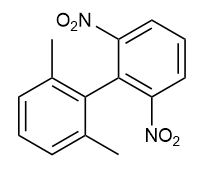This question wants you to check for axial chirality. However, this molecule doesn't possess axial chirality (even though in my haste to answer, I did fall into the trap of saying it did, my apologies.
I did not make not of the fact that the substitution pattern here is symmetrical, and because of the existence of this element of symmetry, the given compound should be achiral.
Axial chirality, which is a special case of chirality in which a molecule does not possess a "stereogenic center" (which is what is most commonly taught in introudctory organic chemistry courses) but an axis of chirality, i.e an axis about which a set of substituents is held in a spatial arrangement that is not superposable on its mirror image.
It is commonly observed in atropisomeric biaryl compounds wherein the rotation about the aryl-aryl bond is restricted. Owing to restricted rotation around the biaryl bond, the two stereoisomers cannot interconvert under ambient conditions. I wrote a lengthy post about chirality in the past; you might find instructive.
Whatever, I said about axial chirality (in my previous post) still holds true, it just isn't applicable in this case. My bad! sorry
Additionally, since OP asked about how to assign stereochemistry in the case of compounds possessing axial chirality, I'll put down a few words on that.
First draw a Newman projection along the axis of hindered rotation. Now assign the ortho, and meta substituents priorities based on Cahn–Ingold–Prelog rules. Now, starting with the substituent of highest priority in the closest ring and moving along the shortest path to the substituent of highest priority in the other ring (as illustrated below), the absolute configuration is assigned P for clockwise and M for counterclockwise. In the example shown, A has priority over B.

Now, try doing this for your given compound, and you run into trouble. You cannot unambiguously assign a configuration.







